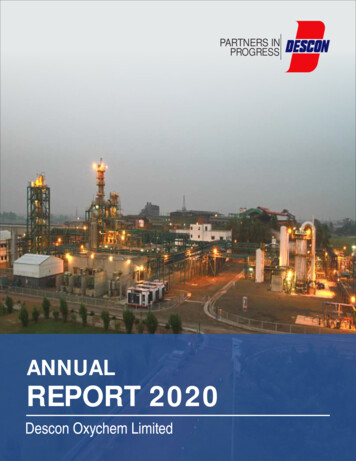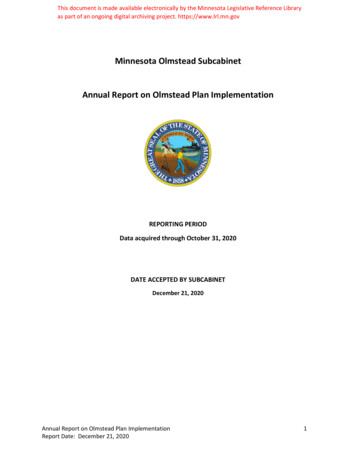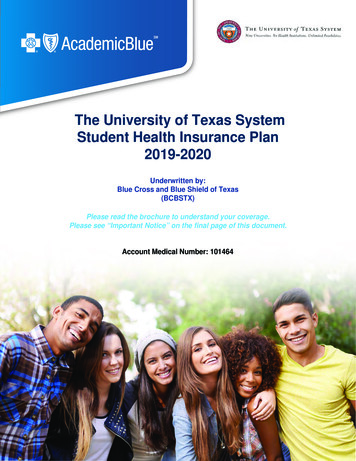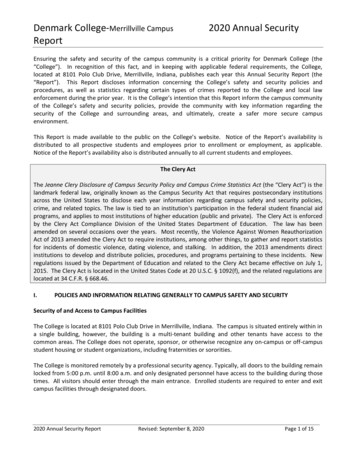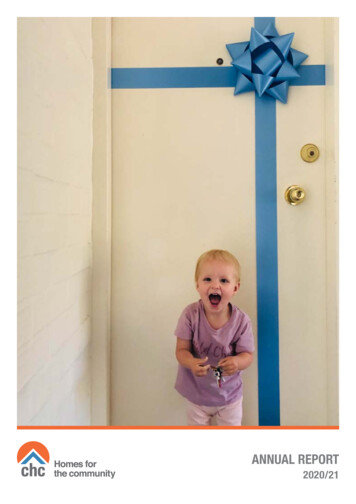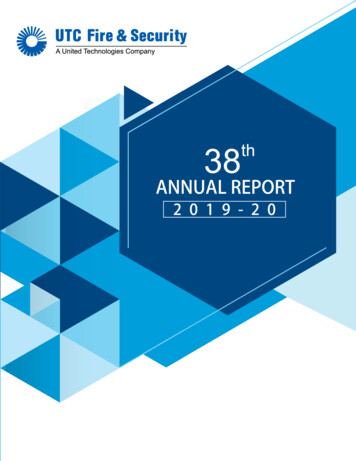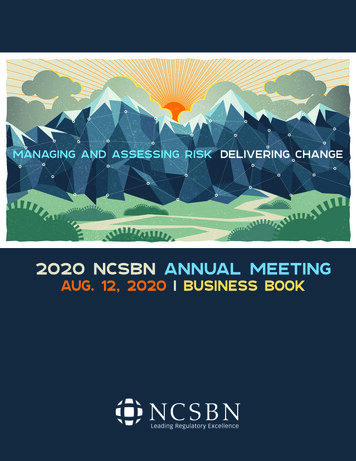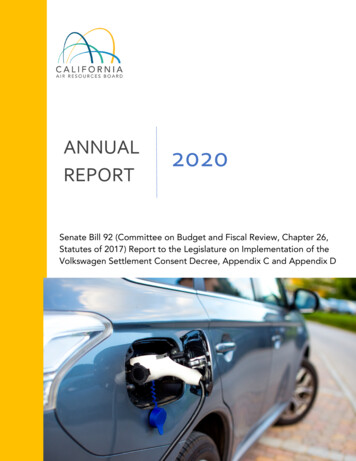
Transcription
ANNUALREPORT2020Senate Bill 92 (Committee on Budget and Fiscal Review, Chapter 26,Statutes of 2017) Report to the Legislature on Implementation of theVolkswagen Settlement Consent Decree, Appendix C and Appendix D
This report can be viewed at rts.To order a hard copy of this report, please contact David Ernest García, Ph.D.,Legislative Director, at (916) 322-8520 or David.Garcia@arb.ca.gov.
TABLE OF CONTENTSExecutive Summary . 2The ZEV Investment Commitment – Consent Decree Appendix C . 6Public Process . 7Approved Cycle 1 Plan Investments . 9Zero-Emission Vehicle Infrastructure: 120 Million .10Green City ZEV Access Demonstration Project (Sacramento): 44 Million .11ZEV Awareness and Education: 20 Million .11Approved Cycle 2 Plan Investments . 12Zero-Emission Vehicle Infrastructure: 153 Million .12Public Education, Awareness, and Marketing activities: 27 Million .13ZEV Investment Plan Progress . 14Zero-Emission Vehicle Infrastructure .14Green City ZEV Access Demonstration Project .15ZEV Awareness and Education .16Total Expenditures .17Low-Income or Disadvantaged Community Benefits . 20VW Environmental Mitigation Trust – Consent Decree Appendix D. 21Public Process . 21Proposed and Actual Trust Expenditures . 22Zero-Emission Transit, School, and Shuttle Buses: 130 Million .23Zero-Emission Class 8 Freight and Port Drayage Trucks: 90 Million .24Zero-Emission Freight and Marine Projects: 70 Million .25Combustion Freight and Marine Projects: 60 Million.26Light-Duty Zero-Emission Vehicle Infrastructure: 10 Million .27Reserve: 63 Million .27Total Expenditures .29Low-Income or Disadvantaged Community Benefits . 311
EXECUTIVE SUMMARYSenate Bill (SB) 92 (Committee on Budget and Fiscal Review, Chapter 26, Statutes of2017), codified at Health and Safety Code section 39614, directs the California AirResources Board (CARB or Board) to provide annual updates to the CaliforniaLegislature on the progress of implementing the Zero Emission Vehicle InvestmentCommitment approved by CARB under Appendix C of the 2.0-Liter Partial ConsentDecree with Volkswagen (VW), and on proposed and actual expenditures of themoneys received pursuant to Appendix D of the 2.0-Liter Partial Consent Decree.1The VW settlement resolves California claims relating to VW’s use of illegal defeatdevices – software designed to cheat on emissions tests – in certain 2009 to 2016model year diesel cars that VW marketed and sold in California. This report coversimplementation of Appendices C and D through December 31, 2019. Staff expectsimplementation will be affected to some extent by Covid-19; staff will addressassociated impacts in the next annual report.A. VW Settlement Requirements in Appendices C and DUnder the terms of the VW settlement, VW will fund or invest more than 1.2 billion inCalifornia over the next 10 years, as follows:·Appendix C, the Zero-Emission Vehicle (ZEV) Investment Commitment, requiresVW to invest 800 million in California over a 10-year period – in four consecutive 200 million, 30-month, ZEV Investment Plan cycles – to support the increased useand availability of ZEVs in the State. Appendix C outlines four areas of qualifiedinvestments: ZEV infrastructure (including developing and maintaining ZEVcharging stations), ZEV public awareness, increased ZEV access, and Green City1The Partial Consent Decrees are available at ement-consent-decrees.2
demonstration projects.2 VW is implementing this commitment through itssubsidiary, Electrify America.·Appendix D, the Environmental Mitigation Trust, is intended to fully mitigate allpast and future excess NOx emissions from the vehicles subject to the settlementby requiring VW to pay about 2.7 billion into a national mitigation trust fund.3California’s allocation of the trust is about 423 million. CARB developed aBeneficiary Mitigation Plan that describes the projects California will fund with itsallocation. The Consent Decree defines the eligible mitigation actions; most arescrap-and-replace projects for the heavy-duty sector.B. CARB has complied with SB 92 in implementing Appendices C and DSB 92 establishes several requirements for Appendices C and D of the 2.0-Liter PartialConsent Decree. Some requirements apply to both Appendices, while others areunique to one or the other. As this report details, CARB continues to meet allrequirements and direction provided by the Legislature in SB 92.One requirement in SB 92 that applies to both Appendices is that CARB must strive toensure that both Appendix C investments and Appendix D expenditures are alignedwith the State’s priorities. Electrify America’s approved Appendix C investmentsunder its Zero Emission Vehicle (ZEV) Investment Plans, and California’s BeneficiaryMitigation Plan expenditures align with the State’s transportation electrification goals,2025 and 2030 ZEV goals, and statutory climate pollutant goals that include reducinggreenhouse gas emissions 40 percent below 1990 levels by 2030. Electrify America’sZEV Investment Plans fund light-, medium-, and heavy-duty electrified vehicles andcharging infrastructure. The Beneficiary Mitigation Plan will fund mostly heavy-dutyscrap and replace projects with an emphasis on zero-emission vehicles and equipment.Appendix C investments and Appendix D expenditures also align with California’s goalof increasing access to clean transportation and mobility options, especially inunderserved areas, as established in the Clean Energy and Pollution Reduction Act of2015 (SB 350, De León, Chapter 547, Statutes of 2015). The publicly approved2The 2.0-Liter Partial Consent Decree provided for a “Green City” initiative in one city. The Californiaonly portion of the 3.0-Liter Partial Consent Decree adds a second Green City demonstration project tobe located in a city with a population of about 500,000 and consisting primarily of disadvantagedcommunities.3This is the total amount required under both the 2.0-Liter and 3.0-Liter Partial Consent Decrees. The3.0-Liter Partial Consent Decree added 225 million to the national Trust and about 41 million toCalifornia’s Trust allocation.3
Appendix C ZEV Investment Plans achieve this goal by installing ZEV infrastructure inunderserved areas and funding ZEV car share and shuttle/bus services that operateprimarily in disadvantaged communities; the Beneficiary Mitigation Plan achieves thisgoal by funding ZEV transit, school, and shuttle buses, many of them servingCalifornia’s low-income or disadvantaged communities.An additional requirement in SB 92 that applies to both appendices is that CARB striveto provide for public transparency before approving Appendix C investments andAppendix D expenditures. To date, CARB has approved the first two of four ZEVInvestment Plans required by Appendix C in public hearings, and has also approvedthe Beneficiary Mitigation Plan required by Appendix D. For each of the ZEVInvestment Plans and the Beneficiary Mitigation Plan, CARB staff undertook anextensive public process that included discussions with stakeholders, publicworkshops, and public board meetings. As part of this public process, CARB postedeach proposed ZEV Investment Plan and the Beneficiary Mitigation Plan for publiccomment before the public hearing to consider adopting the Plans.As it applies to Appendix C, SB 92 further prescribes that:····CARB strive to ensure that: (1) to the maximum extent allowable under the2.0-Liter Partial Consent Decree, at least 35 percent of the funds for each ZEVInvestment Plan benefit low-income or disadvantaged communitiesdisproportionately affected by air pollution, and (2) Volkswagen or its subsidiaryperiodically submit progress reports to CARB on the implementation of theapproved ZEV Investment Plan;CARB approve each ZEV Investment Plan at a public hearing;CARB post each proposed ZEV Investment Plan for public comment; andCARB report annually to the Legislature on the progress of the implementation ofthe approved ZEV Investment Plans.As it applies to Appendix D, the Legislation further prescribes that:··CARB shall strive to ensure, to the maximum extent allowable under the 2.0-LiterPartial Consent Decree, that 35 percent of the moneys received pursuant toAppendix D benefit low-income or disadvantaged communities disproportionatelyaffected by air pollution; andCARB shall report annually to the Legislature on the proposed and actualexpenditures of the moneys received pursuant to Appendix D. As ofDecember 31, 2019, 95 million in funding for two project categories has beenreleased and project selections for those categories are underway. A total of 31,850,000 has been disbursed (expended) from the Trust to date.4
The remainder of this report addresses how CARB met the statutory requirementsprovided above. This second annual report reflects progress made during this earlystage of implementation. As implementation investments grow, CARB staff will haveeven more investment and expenditure information on which to report. CARB staffwill continue to ensure compliance with SB 92.5
THE ZEV INVESTMENT COMMITMENT – CONSENT DECREE APPENDIX CThis section focuses on Appendix C of the 2.0-Liter Partial Consent Decree: The ZEVInvestment Commitment. The ZEV Investment Commitment is intended to function asinjunctive relief that complements the other pieces of the Consent Decree, addressingthe impact to California’s ZEV market resulting from VW’s sale of approximately70,000 2.0-liter high-emitting diesel vehicles in California that VW marketed as cleanvehicles.Under the terms of the ZEV Investment Commitment, VW, through its subsidiary,Electrify America, must invest 800 million in California over a 10-year period – in fourconsecutive 200 million 30-month ZEV Investment Plan cycles – to support theincreased use and availability of ZEVs in the State. Each of Electrify America’s fourseparate 200 million ZEV Investment Plans, which must be approved, in whole or inpart, by the CARB Board, spells out the investments Electrify America proposes tomake within the 30 months in the four areas eligible for investment under the ConsentDecree: ZEV infrastructure (including the development and maintenance of ZEVcharging stations), public awareness, increasing ZEV access, and the establishment oftwo “Green Cities,” with emphasis on transportation electrification projects likezero-emission car sharing and transit to increase mobility, and potentially,zero-emission freight.In addition to the requirements established under the 2.0-Liter Partial Consent Decreeand SB 92, the Board, via Resolution 17-23, has directed that:····Electrify America’s ZEV Investment Plan awareness program materials bebrand-neutral, use a language other than English, when appropriate, and includeacknowledgement of hydrogen fuel cell electric vehicles, when appropriate;Electrify America and CARB prepare and update a census tract-level map ofcharging station investments highlighting low-income and disadvantagedcommunity investments;Electrify America should provide hiring opportunities for qualified residents ofdisadvantaged communities; andCARB staff, after consulting with stakeholders, including environmental justicegroups, labor organizations, auto manufacturers and other EV charging companies,report to the Board at least twice a year on progress toward achieving theobjectives of the Consent Decree.6
PUBLIC PROCESSCARB has now approved the Cycle 1 and Cycle 2 ZEV Investment Plans. Prior toapproval of the Cycle 1 Plan, CARB conducted an extensive public process to informdecision-making on, and implementation and oversight of Electrify America’s ZEVInvestment Plans. From that process, which included an early workshop, the release ofa CARB Guidance Document to help Electrify America consider public and Statefeedback in developing its draft ZEV Investment Plan, and three Board meetings,CARB solidified reporting and disadvantaged community spending commitments fromElectrify America. Tables 1 and 2 on the following pages describe the Cycle 1 andCycle 2 Plan public processes in detail. The Cycle 1 public process was the moreextensive of the two, as it was necessary to include additional foundational meetingsduring which staff educated the public on the 2.0-Liter Partial Consent Decree andsolicited public and Board input that was used to develop CARB’S guiding principlesfor Electrify America in developing the Cycle 1 and 2 Investment Plans.Subsequent to approval of the Cycle 1 Plan, Electrify America began meeting withCARB monthly to discuss the implementation progress of the Cycle 1 Plan and, later,proposed content for and, after approval, provided implementation progress on theCycle 2 Plan. Electrify America and CARB continue to meet monthly to discussimplementation of both the Cycle 1 and Cycle 2 Plans. Electrify America also providesCARB and the public with written quarterly update reports. The company submittedits first, second, and third annual reports, for the 2017, 2018, and 2019 calendar years,respectively, to CARB on April 30, 2018, April 30, 2019, and April 30, 2020,respectively. CARB and Electrify America also provide access to these reports on theirrespective public websites.7
Table 1: Cycle 1 Plan Public ProcessDateActivityInformation ProvidedPublicWorkshopStaff provided details on the Consent Decree and obtained inputfrom the public to help shape guidance (consistent with the ConsentDecree) to Electrify America for use in crafting the Cycle 1 Plan.12/8/16BoardMeetingStaff updated the Board on the Consent Decree, describing thecontent and different functions of the Appendices, and identifiedCARB’s proposed priorities and guidance for the Cycle 1 Plan. Staffalso summarized common themes from the public comments thatwere received at the December 2, 2016, ARB transmitted a Guidance Document4 to Electrify Americaregarding ZEV investment opportunities consistent with theobjectives and criteria set forth in Appendix C, to help informElectrify America’s development of the Cycle 1 Plan.3/14/17PubliclyPosted PlanCARB posted Electrify America’s proposed Cycle 1 ZEV InvestmentPlan5 for a four-week public comment period.3/24/17BoardMeetingStaff provided an overview of Electrify America’s proposed Cycle 1Plan. Board members and stakeholders expressed concern that thePlan did not adequately respond to some of CARB’s FebruaryGuidance Document. In response, CARB committed to solicitingadditional information from Electrify America addressing theconcerns regarding the submitted Cycle 1 Plan.5/24/17PubliclyPostedRequest forSupplementCARB outlined proposed Cycle 1 Plan concerns and requested thatElectrify America submit a Plan Supplement with more informationon proposed expenditures in disadvantaged communities, brandneutral infrastructure and education, and a long-term investmentplanning vision. Electrify America submitted the Supplement onJune 29, 2017.7/27/17BoardMeetingStaff provided an overview of Electrify America’s proposed Cycle 1Plan – including its Supplement – as submitted on June 29, 2017,and made available for public comment; the Board approved thePlan.12/2/164CARB, 2017. California Air Resources Board’s Guidance to Volkswagen on First 30 Month ElectricVehicle Infrastructure Investment Plan of the 2.0 Liter Diesel Engine Partial Consent Decree Settlement,February 10, 2017.(https://www.arb.ca.gov/msprog/vw info/vsi/vw-zevinvest/documents/carb guidance 021017.pdf)5Electrify America, 2017. California ZEV Investment Plan: Cycle 1, March 8, 2017. 01.pdf)8
Table 2: Cycle 2 Plan Public ProcessDateActivityInformation ProvidedPubliclyPosted PlanCARB posted Electrify America’s proposed Cycle 2 ZEV InvestmentPlan6 for public comment.11/15/18BoardMeetingStaff provided an overview of the proposed Cycle 2 Plan. TheBoard did not have a quorum to vote on the Plan, and expressedconcern that staff had not solicited enough comments fromstakeholders regarding Electrify America’s progress towardachieving the objectives of the 2.0-liter Partial Consent Decree, asrequired by the Board.12/7/18PublicMeetingCARB solicited additional comments from stakeholders regardingElectrify America’s progress toward achieving the objectives of the2.0-liter Partial Consent Decree.12/13/18BoardMeetingStaff provided an overview of the proposed Cycle 2 Plan andadditional stakeholder feedback; the Board approved the Plan.10/3/18APPROVED CYCLE 1 PLAN INVESTMENTSCARB approved Electrify America’s Cycle 1 ZEV Investment Plan on July 27, 2017.The Cycle 1 Plan covers the 30-month period concluding on June 30, 2019. Table 3below shows the project funding categories and investment amounts approved by theBoard for the Cycle 1 Plan. The funding categories are consistent with the objectivesand criteria set forth in Appendix C and SB 92, and were refined during an extensivepublic process. The Cycle 1 Plan investments are further described after the table.6Electrify America, 2018. California ZEV Investment Plan: Cycle 2, October 3, 2018. an.pdf)9
Table 3: Approved Cycle 1 Plan Investments7Investment(in millions)Investment CategoryZEV Infrastructure 120Green City ZEV Access Demonstration Project (Sacramento) 44ZEV Awareness and Education 20Operational Expenses 16TOTAL 200ZERO-EMISSION VEHICLE INFRASTRUCTURE: 120 MILLIONThe majority of this investment – 75 million – was used to install astatewide network of highwayfast-charging stations that will serve all ofCalifornia’s plug-in drivers and allow forultra-fast refueling – 200 miles in15-30 minutes. The remainder of thisinvestment was used to installImage source: Electrify America Newsfast-charging and 208-240 volt Level 2Update, December 13, 2018.charging at retail and community locations,municipal parking facilities, workplaces,and multi-family housing units in the following six California metropolitan areas:Fresno, Los Angeles-Long Beach-Anaheim, Sacramento-Roseville-Arden Arcade,San Diego-Carlsbad-San Marcos, San Francisco-Oakland-Hayward, and San JoseSunnyvale-Santa Clara. Approximately 5.2 million in ongoing Cycle 1 infrastructurefunding that was unspent as of December 31, 2019, will fund infrastructure activity inCycle 2 as allowed under the terms of the ZEV Investment Commitment.7Table 3 only reflects approved Cycle 1 Plan investments. An exhibit of actual Cycle 1 Planexpenditures may be found in Table 6.10
GREEN CITY ZEV ACCESS DEMONSTRATION PROJECT (SACRAMENTO): 44 MILLIONThe Green City investment in Sacramento issupporting two new car sharing services - GIGand Envoy, a new zero-emission on-demandshuttle bus service along the Franklin Boulevardcorridor, an area of the city which had beenwithout a bus line; new zero-emission transitbuses operating between the Davis andSacramento campuses of the University ofCalifornia, Davis; and the charging infrastructureImage source: CARBand marketing associated with each of theseprojects. Almost 19 million of the 44 million investment is supporting fast-chargingfor GIG Chevrolet Bolt EVs and transit buses, and Level 2 charging for Envoy e-Golfs.Finally, Electrify America selected 3Fold Communications, a marketing agency withestablished connections to Sacramento’s low-income and disadvantaged communities,to create a Green City awareness campaign called Sac-to-Zero8 to grow awarenessand use of Sacramento’s Green City programs. Approximately 3.5 million in ongoingCycle 1 Green City funding that was unspent as of December 31, 2019, will fundadditional Green City activities in Cycle 2 as allowed under the terms of the ZEVInvestment Commitment.ZEV AWARENESS AND EDUCATION: 20 MILLIONElectrify America, during development of itsCycle 1 Plan, shared third-party researchindicating that more than half of allCalifornians were unaware of ZEVs.Electrify America’s implemented awarenessplan has generated broad, brand-neutralZEV awareness, through a combination ofweb-based, social, and traditional (TV andradio) media.Image source: Jetstones TV Ad screencapture8Sac-to-Zero’s website is at https://sactozero.com/11
APPROVED CYCLE 2 PLAN INVESTMENTSCARB approved Electrify America’s Cycle 2 ZEV Investment Plan onDecember 13, 2018. The Cycle 2 Plan covers the 30-month period from July 1, 2019through December 31, 2021. The 2.0-Liter Partial Consent Decree provides thatVolkswagen may also complete its Cycle 1 spending activities during Cycle 2 withoutpenalty. Table 4 below shows the project funding categories and investment amountsapproved by the Board for the Cycle 2 Plan. The funding categories are consistentwith the objectives and criteria set forth in Appendix C and SB 92, and were refinedduring a public process that included a stakeholder meeting and two Board meetings.The proposed investments are further described after the table.Table 4: Approved Cycle 2 Plan Investments9Investment(in millions)Investment CategoryZEV Infrastructure 153Public Education, Awareness, and Marketing Activities 27Operational Expenses 20TOTAL 200ZERO-EMISSION VEHICLE INFRASTRUCTURE: 153 MILLIONImage source: /e-tron-taking-chargeMost of this investment, 95-115 million, willbe used to expand charging infrastructurewithin the 6 metropolitan areas selected inCycle 1, as well as in 3 new areas: RiversideSan Bernardino, Santa Cruz-Watsonville, andSanta Rosa. These nine metropolitan areas areprojected to have 89 percent of the 2022plug-in electric vehicle population in the State.Another 25-30 million will be used to expandprimarily fast-charging infrastructure alonghighways and regional routes, including inthree rural areas with high concentrations of9Table 4 only reflects approved Cycle 2 Plan investments. An exhibit of actual Cycle 2 Planexpenditures may be found in Table 7.12
low-income or disadvantaged communities (the Central, Coachella, and ImperialValleys). Additionally, 8-12 million will go toward 2,500-3,300 residential Level 2,demand response-capable chargers and a website tool, integrated with CARB toolstargeted toward low-income consumers, to identify existing incentives; 4-6 millionwill go toward charging infrastructure for electrified transit buses; 2-4 million will gotoward autonomous vehicle charging, to facilitate fueling the coming generation ofautonomous plug-in electric vehicles (PEVs); approximately 2 million will go towardLevel 2 charging in rural areas that have historically been underserved by charginginfrastructure10; and up to 5 million will go toward renewable generation that willdecrease upstream emissions from electricity generation and provide for greatereconomic sustainability.PUBLIC EDUCATION, AWARENESS, AND MARKETING ACTIVITIES: 27 MILLIONIn Cycle 2, Electrify America will continue to use traditional andsocial media to increase public awareness of ZEVs and theirbenefits, emphasizing the: (1) performance and comfortcharacteristics that drivers say they want, (2) range confidence(including the range of new vehicles and the convenience ofpublic charging infrastructure), and (3) diversity of vehiclechoice. As awareness levels increase, Electrify America willdirectly target marketing at this ZEV-aware audience, using rideand drive events and, potentially, experience centers, topromote even stronger ZEV consideration.Image source: ElectrifyAmerica Report toCalifornia, May 10, 2018Electrify America will use marketing to boost station utilization. Messaging willcommunicate, for each charging station, location, charging speed, acceptablepayment methods, and nearby amenities. It will also communicate information onaccessibility, subscription plans and other efforts to improve affordability, andagreements to provide ultra-fast charging services to buyers of electric vehicles from atotal of seven brands (six automotive and one motorcycle).10In a written request to Electrify America, rural community stakeholders and advocates expressed that:(1) they preferred Level 2 charging because of the typically lower cost, and (2) charger siting shouldprioritize health centers and educational institutions as these sites are visited frequently and offerextended hours of access. Electrify America has stated that they will target these stations towardeducational and health care institutions, with site host permission.13
ZEV INVESTMENT PLAN PROGRESSAs required under the Consent Decree, Electrify America has submitted its 2019annual report on time. CARB staff has reviewed the report and found that meaningfulprogress has been made toward the investment goals established in the Cycle 1 and 2Plans, especially in the rollout of charging infrastructure. The following sections firstilluminate Electrify America progress as of December 31, 2019, in each of the Cycle 1and Cycle 2 investment plan categories and then present expenditure tables (Tables 6and 7) for the two investment plans.ZERO-EMISSION VEHICLE INFRASTRUCTUREAs previously mentioned in the descriptions of the Cycle 1 and 2 ZEV InvestmentPlans, Electrify America expected to deploy direct current (DC) fast chargers at siteslocated both along highway corridors and in the Fresno, Los Angeles,Riverside-San Bernardino, Sacramento, San Francisco, San Diego, San Jose,Santa Cruz-Watsonville, and Santa Rosa metropolitan areas. It also expected todeploy Level 2 charging stations at workplace and multi-unit dwellings (MUD) withinthe same metropolitan areas. Table 5 below reflects deployment status through thefourth calendar quarter (Q4) of 2018 and 2019.Table 5: Charging Infrastructure StatusDC Fast Charging StationsStatusLevel 2 Charging StationsQ4 2018Q4 2019In permitting134165Permit complete62152Site work complete14128Operational578StatusSite agreementsexecutedOperationalQ4 2018Q4 201923924174241Electrify America reports that 54 percent of the operational DC fast chargers and42 percent of the operational Level 2 chargers are in disadvantaged and low-incomecommunities. CARB staff are verifying that reported stations are in disadvantaged andlow-income census tracts by cross-checking them with census tracts identified byCalEnviroScreen 3.0 and AB 1550 as disadvantaged and/or low income and mappingthem through ArcGIS.14
Additionally, Electrify America is incorporating onsite battery storage, which, usinglower-priced energy stored during low-demand periods, can reduce high utilitydemand charges and on-peak energy charges, while easing grid loads. In early 2019,it ordered more than 20 megawatt-hours of Tesla storage batteries to be sited atmore than 60 of its DC fast charge stations in California, and efforts are under way toidentify those stations best suited for battery storage placement.GREEN CITY ZEV ACCESS DEMONSTRATION PROJECTThrough its first Green City Initiative, Electrify America continued to invest inzero-emission car sharing and transit in Sacramento, and associated charginginfrastructure.11 The GIG free-float (point-to-point) car share fleet in Sacramento grewfrom 100 to the planned 260 Chevrolet Bolt EVs with roof-mounted bike racks in thefirst half of 2019; it is currently the largest all-electric car share fleet in the UnitedStates. Through the end of 2019, the GIG fleet had made more than 94,000 trips andlogged more than 871,000 miles. GIG estimates that 60 percent of its 18-square mile“home zone” is comprised of disadvantaged and low-income census tracts. TheEnvoy Tech
Decree with Volkswagen (VW), and on proposed and actual expenditures of the moneys received pursuant to Appendix D of the 2.0-Liter Partial Consent Decree. 1. The VW settlement resolves California claims relating to. VW's use of illegal defeat devices - software designed to cheat on emissions tests - in certain 2009 to 2016




